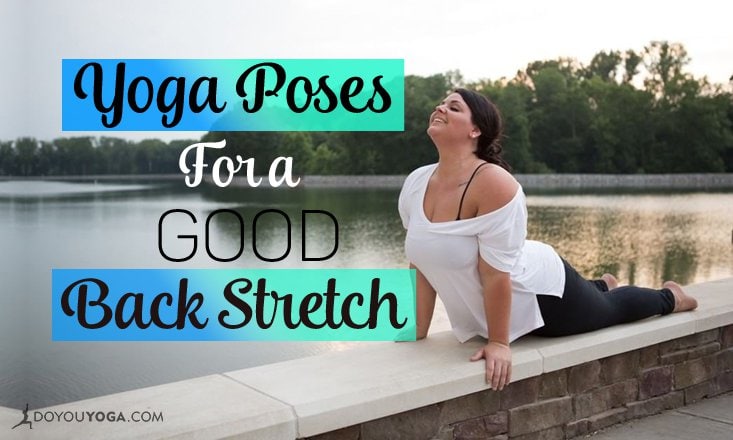While it might be tricky to distinguish which of the following rhomboid major, longissimus, or clavier is not like the others (hint: two are back muscles and one is a keyboard instrument like a harpsichord), most people can recognize and have experienced the pain of a tight back.
The feeling of stiffness, soreness, and restricted mobility can lead to trouble sleeping, muscle spasms, and stress induced anxiety. Having a tight back is the worst, so to help relieve some of that back pain, here are some anatomical pointers as well as a few friendly yoga poses that will give you a good back stretch!
Anatomical Pointers
The human back encompasses the area from the top of the butt to the nape and consists many things including the back muscles and the vertebral column. The muscles of the back are divided into three main categories: superficial, intermediate, and deep/intrinsic.
From tailbone to in-between the ears, the vertebral column consists of the coccygeal vertebrae, sacrum, lumbar vertebrae, thoracic vertebrae, and cervical vertebrae which are divided into the sacral curve, lumbar curve, thoracic curve, and cervical curve.
The vertebral column is also known more generally as the spine. Movements of the spine consist of flexion, extension, axial rotation, and lateral flexion.
1. Garudasana (Eagle Pose) Arms for the Superficial Back Muscles
 Credit: Christie Pitko
Credit: Christie PitkoThe superficial back muscles include the trapezius, latissimus dorsi, levator scapulae and the rhomboids (major and minor) and are associated with movements of the shoulder. Eagle arms can be practiced seating or standing to stretch and strengthen the superficial back muscles.
Practice Tip: Since Eagle arms constrict movement and compress in the front of the body, inviting breath into the back of the body helps deepen the pose as well as release tension in the back.
2. Dandasana (Staff Pose) for the Intermediate Back Muscles
The serratus posterior superior and inferior are the intermediate back muscles associated with movements of the thoracic cage, which is a fancy way of saying they assist with an important function in yoga called breathing.
Practice Tip: Maintaining an erect spine invites a direct path for energy flow and activating the bandhas makes this pose one of the most challenging to maintain focus while also strengthening the spine and supporting back muscles.
3. Prasarita Padottanasana (Wide-Stance Forward Bend) for the Intrinsic Back Muscles

The intrinsic back muscles are also divided into three layers: superficial, intermediate, and deep. While some of these muscles only run a short distance from the nape to the base of the neck, some of these muscles run all the way down the spine.
The intrinsic muscles are associated with movements of the vertebral column. Poses like wide-stance forward bend invite passive lengthening of the spinal muscles and mild flexion of the spine.
4. Balasana (Child’s Pose) for Spinal Flexion

Spinal flexion, or the act of bending forward, can be practiced in various asanas like Child’s Pose or Forward Fold (seated or standing). In Child’s Pose, the spinal muscles passively lengthen and the flexion compresses the abdomen to invite breath into the back body.
5. Bhujangasana (Cobra Pose) for Spinal Extension
Spinal extension, or the act of bending backward, can be practiced in various asanas like Cobra Pose, Bridge, or Wheel. In Cobra Pose, locating and activating the deep intrinsic back muscles that run the length of the spine help with spinal extension as well as protect the tender lower back.
6. Ardha Matsyendrasana (Half Lord of the Fishes Pose) for Axial Rotation
Axial rotation, or better known as twisting, can be practiced in various asanas like Half Lord of the Fishes Pose, Revolved Side Angle Pose, and Jathara Parivrtti (belly twists). Half Lord of the Fishes Pose is a spinal rotator that strengthens and lengthens the erector spinae, serratus posterior, and rhomboids muscles.
7. Parivrtta Janu Sirsasana (Revolved Head-to-Knee Pose) for Lateral Flexion
Lateral Flexion, also known as side bending, can be practiced in various asanas like Revolved Head-to-Knee Pose or Gate Pose. Revolved Head-to-Knee Pose is a deep stretch for the trapezius, rhomboids, spinal extensors, and latissimus dorsi.
Back pain and tightness can lead to a vicious cycle where the pain prevents movement and exercise that could ease some of the pain away. These yoga poses can be incorporated today for a good back stretch to ease away pain as well as work to proactively strengthen and stretch the back to keep tightness at bay.
Have any other good poses for a strong and healthy back? Please share in the comment section below!
Image Credit: Brittany Danielle






